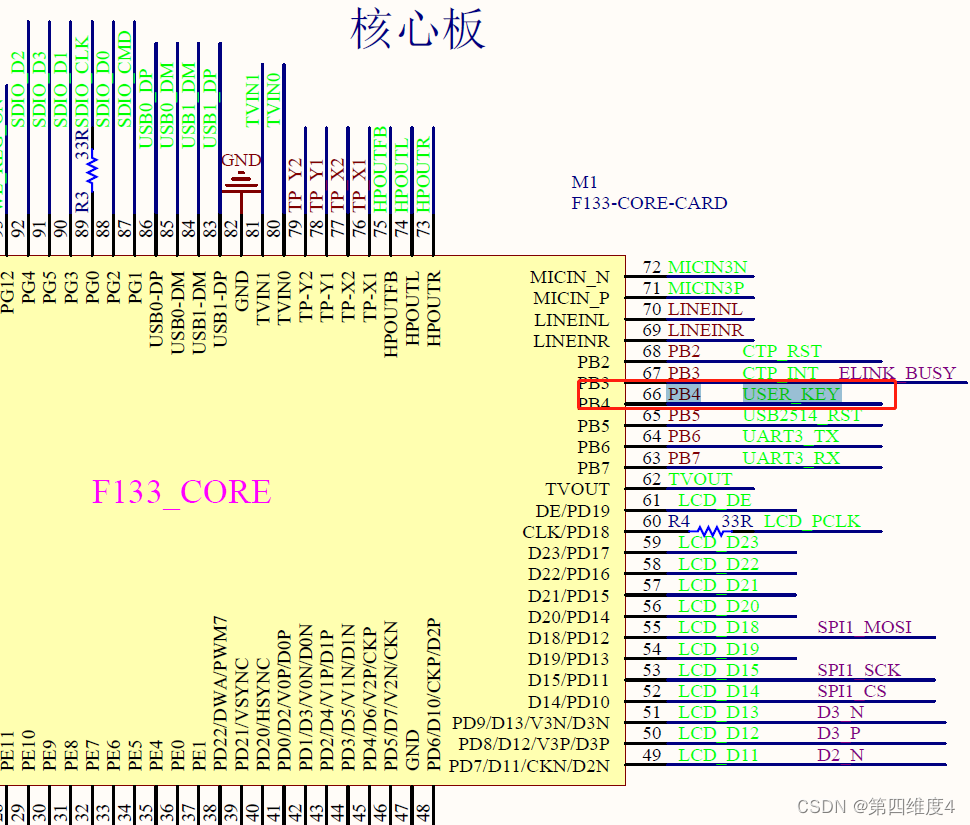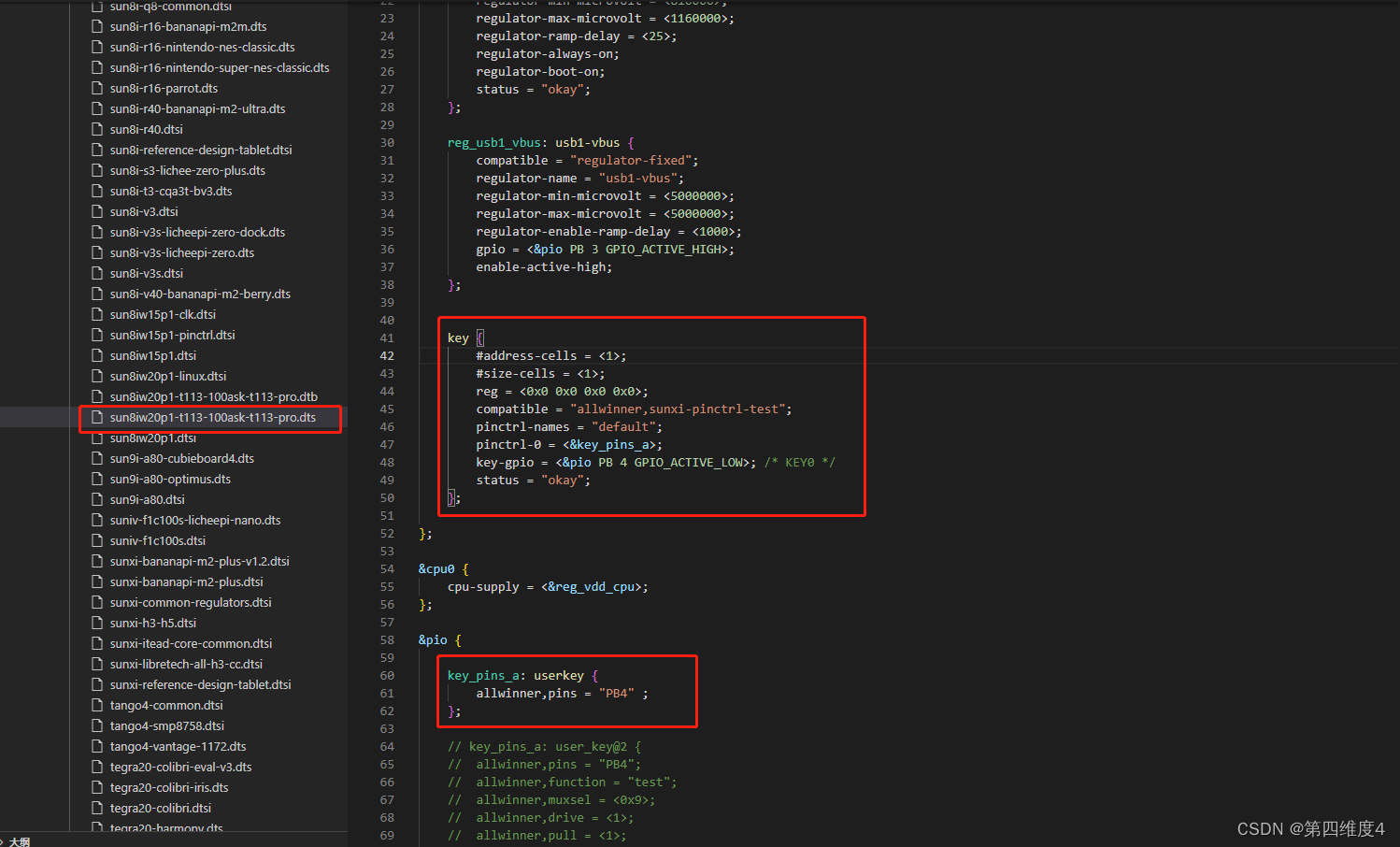【全志T113-S3_100ask】4-编写按键驱动(atomic + poll)
-
前言
本来想写一下点灯的驱动的,结果发现板子上没有用户的led灯?????那就试着写一下按键的驱动吧。
(一)查看原理图
在原理图里,找到了用户按键USER KEY的内容

并且是连接在核心板的PB 4 引脚上

看起来没有用作其他功能。
(二)修改设备树
设备树在以下目录里
/disk/buildroot-100ask_t113-pro/buildroot/output/build/linux-d96275805a67d54998123d36e59108cb1ed52ad5/arch/arm/boot/dts添加一级子节点
key { #address-cells = <1>; #size-cells = <1>; reg = <0x0 0x0 0x0 0x0>; compatible = "allwinner,sunxi-pinctrl-test"; pinctrl-names = "default"; pinctrl-0 = <&key_pins_a>; key-gpio = <&pio PB 4 GPIO_ACTIVE_LOW>; /* KEY0 */ status = "okay"; };添加 pio
key_pins_a: userkey { allwinner,pins = "PB4" ; };添加后如下:

(三)编写驱动 key_drv.c
#include <linux/types.h> #include <linux/kernel.h> #include <linux/delay.h> #include <linux/ide.h> #include <linux/init.h> #include <linux/module.h> #include <linux/errno.h> #include <linux/gpio.h> #include <linux/cdev.h> #include <linux/device.h> #include <linux/of.h> #include <linux/of_address.h> #include <linux/of_gpio.h> #include <linux/semaphore.h> #include <asm/mach/map.h> #include <asm/uaccess.h> #include <asm/io.h> #define KEY_CNT 1 /* 设备号个数 */ #define KEY_NAME "key" /* 名字 */ /* 定义按键值 */ #define KEY0VALUE 0XF0 /* 按键值 */ #define INVAKEY 0X00 /* 无效的按键值 */ /* key设备结构体 */ struct key_dev{ dev_t devid; /* 设备号 */ struct cdev cdev; /* cdev */ struct class *class; /* 类 */ struct device *device; /* 设备 */ int major; /* 主设备号 */ int minor; /* 次设备号 */ struct device_node *nd; /* 设备节点 */ int key_gpio; /* key所使用的GPIO编号 */ atomic_t keyvalue; /* 按键值 */ }; struct key_dev keydev; /* key设备 */ /* * @description : 初始化按键IO,open函数打开驱动的时候 * 初始化按键所使用的GPIO引脚。 * @param : 无 * @return : 无 */ static int keyio_init(void) { keydev.nd = of_find_node_by_path("/key"); if (keydev.nd== NULL) { return -EINVAL; } keydev.key_gpio = of_get_named_gpio(keydev.nd ,"key-gpio", 0); if (keydev.key_gpio < 0) { printk("can't get key0\r\n"); return -EINVAL; } printk("key_gpio=%d\r\n", keydev.key_gpio); /* 初始化key所使用的IO */ gpio_request(keydev.key_gpio, "key0"); /* 请求IO */ gpio_direction_input(keydev.key_gpio); /* 设置为输入 */ return 0; } /* * @description : 打开设备 * @param - inode : 传递给驱动的inode * @param - filp : 设备文件,file结构体有个叫做private_data的成员变量 * 一般在open的时候将private_data指向设备结构体。 * @return : 0 成功;其他 失败 */ static int key_open(struct inode *inode, struct file *filp) { int ret = 0; filp->private_data = &keydev; /* 设置私有数据 */ ret = keyio_init(); /* 初始化按键IO */ if (ret < 0) { return ret; } return 0; } /* * @description : 从设备读取数据 * @param - filp : 要打开的设备文件(文件描述符) * @param - buf : 返回给用户空间的数据缓冲区 * @param - cnt : 要读取的数据长度 * @param - offt : 相对于文件首地址的偏移 * @return : 读取的字节数,如果为负值,表示读取失败 */ static ssize_t key_read(struct file *filp, char __user *buf, size_t cnt, loff_t *offt) { int ret = 0; int value; struct key_dev *dev = filp->private_data; if (gpio_get_value(dev->key_gpio) == 0) { /* key0按下 */ while(!gpio_get_value(dev->key_gpio)); /* 等待按键释放 */ atomic_set(&dev->keyvalue, KEY0VALUE); } else { atomic_set(&dev->keyvalue, INVAKEY); /* 无效的按键值 */ } value = atomic_read(&dev->keyvalue); ret = copy_to_user(buf, &value, sizeof(value)); return ret; } /* * @description : 向设备写数据 * @param - filp : 设备文件,表示打开的文件描述符 * @param - buf : 要写给设备写入的数据 * @param - cnt : 要写入的数据长度 * @param - offt : 相对于文件首地址的偏移 * @return : 写入的字节数,如果为负值,表示写入失败 */ static ssize_t key_write(struct file *filp, const char __user *buf, size_t cnt, loff_t *offt) { return 0; } /* * @description : 关闭/释放设备 * @param - filp : 要关闭的设备文件(文件描述符) * @return : 0 成功;其他 失败 */ static int key_release(struct inode *inode, struct file *filp) { return 0; } /* 设备操作函数 */ static struct file_operations key_fops = { .owner = THIS_MODULE, .open = key_open, .read = key_read, .write = key_write, .release = key_release, }; /* * @description : 驱动入口函数 * @param : 无 * @return : 无 */ static int __init mykey_init(void) { /* 初始化原子变量 */ atomic_set(&keydev.keyvalue, INVAKEY); /* 注册字符设备驱动 */ /* 1、创建设备号 */ if (keydev.major) { /* 定义了设备号 */ keydev.devid = MKDEV(keydev.major, 0); register_chrdev_region(keydev.devid, KEY_CNT, KEY_NAME); } else { /* 没有定义设备号 */ alloc_chrdev_region(&keydev.devid, 0, KEY_CNT, KEY_NAME); /* 申请设备号 */ keydev.major = MAJOR(keydev.devid); /* 获取分配号的主设备号 */ keydev.minor = MINOR(keydev.devid); /* 获取分配号的次设备号 */ } /* 2、初始化cdev */ keydev.cdev.owner = THIS_MODULE; cdev_init(&keydev.cdev, &key_fops); /* 3、添加一个cdev */ cdev_add(&keydev.cdev, keydev.devid, KEY_CNT); /* 4、创建类 */ keydev.class = class_create(THIS_MODULE, KEY_NAME); if (IS_ERR(keydev.class)) { return PTR_ERR(keydev.class); } /* 5、创建设备 */ keydev.device = device_create(keydev.class, NULL, keydev.devid, NULL, KEY_NAME); if (IS_ERR(keydev.device)) { return PTR_ERR(keydev.device); } return 0; } /* * @description : 驱动出口函数 * @param : 无 * @return : 无 */ static void __exit mykey_exit(void) { /* 注销字符设备驱动 */ gpio_free(keydev.key_gpio); cdev_del(&keydev.cdev);/* 删除cdev */ unregister_chrdev_region(keydev.devid, KEY_CNT); /* 注销设备号 */ device_destroy(keydev.class, keydev.devid); class_destroy(keydev.class); } module_init(mykey_init); module_exit(mykey_exit); MODULE_LICENSE("GPL"); MODULE_AUTHOR("z");参考了正点原子的按键驱动:
(四)编写测试应用 key_drv_test.c
#include "stdio.h" #include "unistd.h" #include "sys/types.h" #include "sys/stat.h" #include "fcntl.h" #include "stdlib.h" #include "string.h" /* 定义按键值 */ #define KEY0VALUE 0XF0 #define INVAKEY 0X00 /* * @description : main主程序 * @param - argc : argv数组元素个数 * @param - argv : 具体参数 * @return : 0 成功;其他 失败 */ int main(int argc, char *argv[]) { int fd, ret; char *filename; int keyvalue; if(argc != 2){ printf("Error Usage!\r\n"); return -1; } filename = argv[1]; /* 打开key驱动 */ fd = open(filename, O_RDWR); if(fd < 0){ printf("file %s open failed!\r\n", argv[1]); return -1; } /* 循环读取按键值数据! */ while(1) { read(fd, &keyvalue, sizeof(keyvalue)); if (keyvalue == KEY0VALUE) { /* KEY0 */ printf("KEY0 Press, value = %#X\r\n", keyvalue); /* 按下 */ } } ret= close(fd); /* 关闭文件 */ if(ret < 0){ printf("file %s close failed!\r\n", argv[1]); return -1; } return 0; }(五)编写Makefile
KERN_DIR = /disk/buildroot-100ask_t113-pro/buildroot/output/build/linux-d96275805a67d54998123d36e59108cb1ed52ad5 all: make -C $(KERN_DIR) M=`pwd` modules $(CROSS_COMPILE)gcc -o key_drv_test key_drv_test.c clean: make -C $(KERN_DIR) M=`pwd` modules clean rm -rf modules.order rm -f key_drv_test obj-m += key_drv.o(六)测试
编译驱动
root@znh-ubuntu:/disk/vsCode/04_key# ls key_drv.c key_drv_test.c Makefile root@znh-ubuntu:/disk/vsCode/04_key# make make -C /disk/buildroot-100ask_t113-pro/buildroot/output/build/linux-d96275805a67d54998123d36e59108cb1ed52ad5 M=`pwd` modules make[1]: 进入目录“/disk/buildroot-100ask_t113-pro/buildroot/output/build/linux-d96275805a67d54998123d36e59108cb1ed52ad5” CC [M] /disk/vsCode/04_key/key_drv.o Building modules, stage 2. MODPOST 1 modules CC [M] /disk/vsCode/04_key/key_drv.mod.o LD [M] /disk/vsCode/04_key/key_drv.ko make[1]: 离开目录“/disk/buildroot-100ask_t113-pro/buildroot/output/build/linux-d96275805a67d54998123d36e59108cb1ed52ad5” arm-linux-gnueabi-gcc -o key_drv_test key_drv_test.c root@znh-ubuntu:/disk/vsCode/04_key# ls key_drv.c key_drv.mod key_drv.mod.o key_drv_test Makefile Module.symvers key_drv.ko key_drv.mod.c key_drv.o key_drv_test.c modules.order root@znh-ubuntu:/disk/vsCode/04_key#编译kernel、buildroot、烧卡、tftp:略
测试驱动
# chmod 777 key_drv_test # ls key_drv.ko key_drv_test # insmod key_drv.ko [ 162.979954] key_drv: loading out-of-tree module taints kernel. # ./key_drv_test /dev/key [ 166.293872] key_gpio=36 KEY0 Press, value = 0XF0 KEY0 Press, value = 0XF0 KEY0 Press, value = 0XF0 ^C # ls /proc/device-tree #address-cells memory@40000000 #size-cells model aliases name chosen pio-18 compatible pio-33 cpu-opp-table pmu cpus power-management@ff000000 dcxo24M_clk psci dram rc16m_clk dump_reg@20000 share_space@0x42100000 ext32k_clk soc@3000000 firmware thermal-zones interrupt-controller@3020000 timer_arch interrupt-parent usb1-vbus iommu@2010000 vdd-cpu key至此,按键驱动完成,但是还有很多需要修改的地方吧,或者很多冗余的东西,以后再修改了。
原文链接:https://blog.csdn.net/qq_46079439/article/details/125899592
Copyright © 2024 深圳全志在线有限公司 粤ICP备2021084185号 粤公网安备44030502007680号